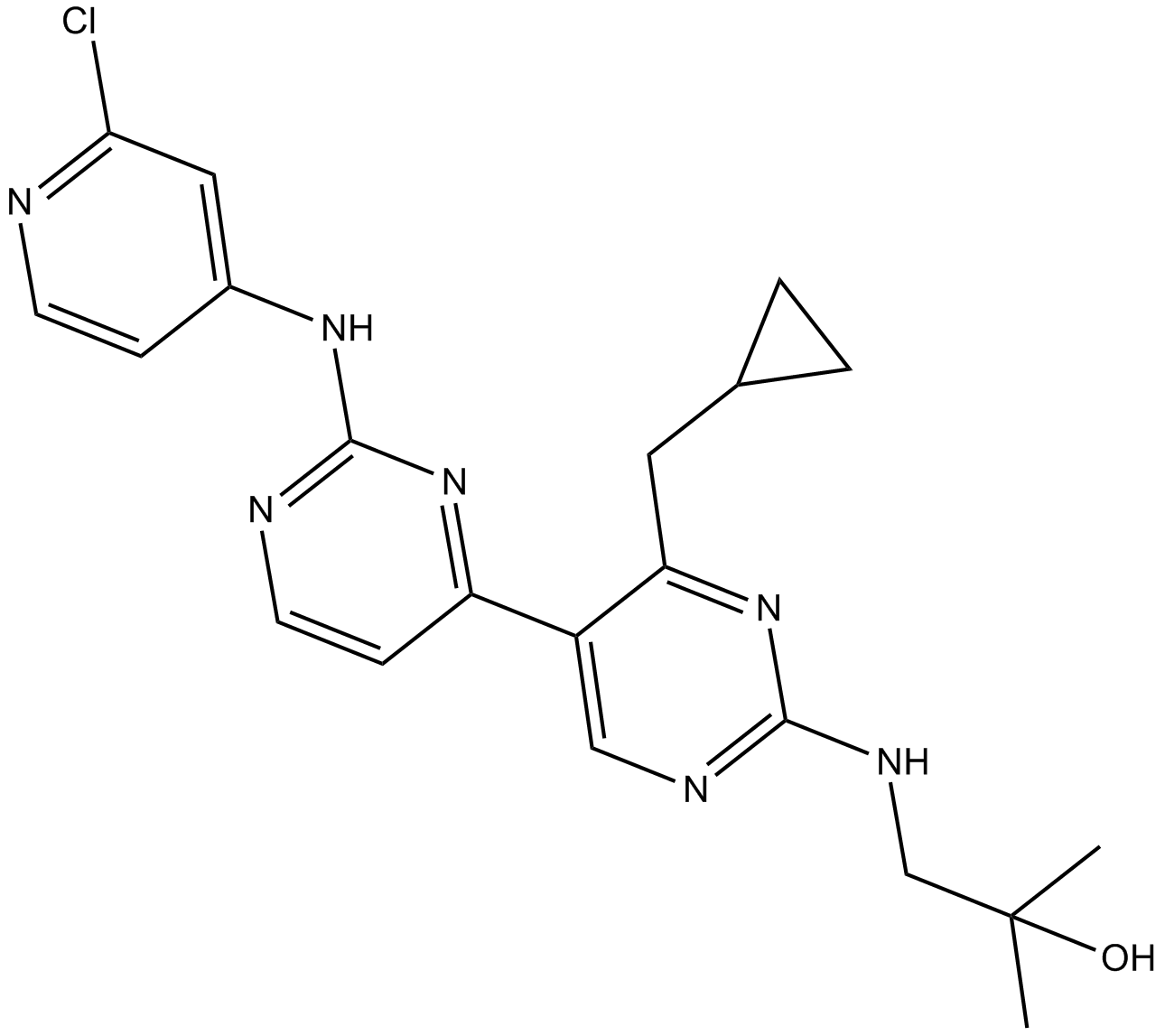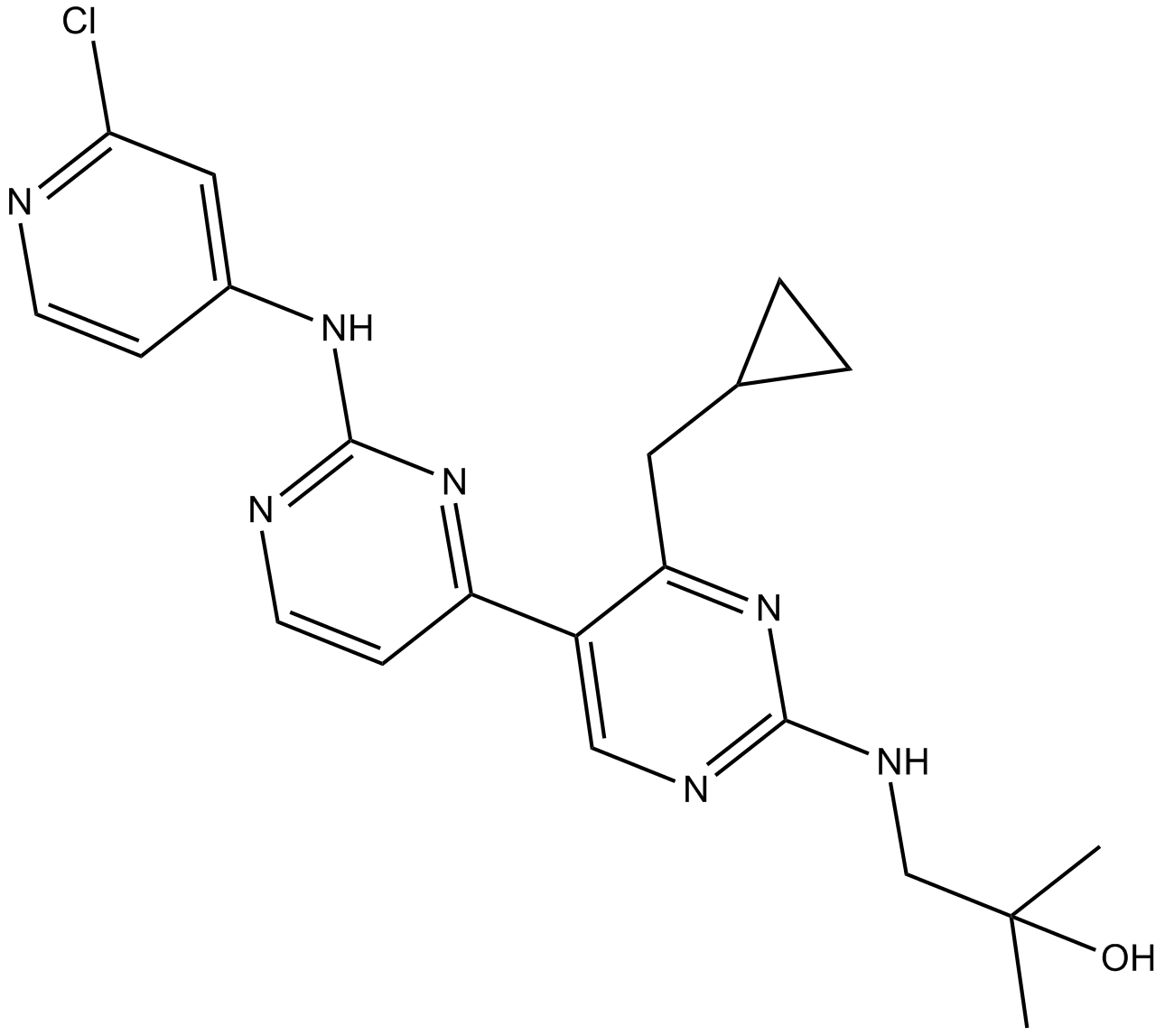VPS34-IN1
IC50: 25 nM
VPS34-IN1 is a Vps34 inhibitor.
The vacuolar protein sorting 34 (Vps34) class III phosphoinositide 3-kinase (PI3K) phosphorylates phosphatidylinositol (PtdIns) to generate PtdIns(3)P that regulates membrane trafficking processes through its ability to recruit a subset of proteins possessing PtdIns(3)P-binding phox homology (PX) and FYVE domains.
In vitro: VPS34-IN1 was identified to be able to inhibit in-vitro Vps34, but did not significantly inhibit the activity of tested 340 protein kinases or 25 lipid kinases that include all isoforms of class I and class II PI3Ks. Treatment of VPS34-IN1 to cells dose-dependently induced a quick dispersal of a specific PtdIns(3)P-binding probe, without altering the ability of class I PI3K to regulate Akt. Moreover, VPS34-IN1 could also induce a quick ~50-60% loss of SGK3 phosphorylation within 1 min. However, VPS34-IN1 could not inhibit activity of the SGK2 isoform without a PtdIns(3)P-binding PX domain. In addition, the combination of VPS34-IN1 and class I PI3K inhibitor of GDC-0941 resulted in the reduced SGK3 activity ~80-90%. Therefore, these data demonstrated that VPS34-IN1 would be a useful probe to delineate physiological roles of the Vps34 and the combination of class I such as GDC-0941 and class III such as VPS34-IN1 PI3K inhibitors could be used to better analyse the roles and regulation of the elusive class II PI3K [1].
In vivo: So far, there is no animal in vivo data reported.
Clinical trial: Up to now, VPS34-IN1 is still in the preclinical development stage.
Reference:
[1] Bago R et al. Characterization of VPS34-IN1, a selective inhibitor of Vps34, reveals that the phosphatidylinositol 3-phosphate-binding SGK3 protein kinase is a downstream target of class III phosphoinositide 3-kinase. Biochem J.2014 Nov 1;463(3):413-27.
- 1. Elias Adriaenssens, Stefan Schaar, et al. "Reconstitution of BNIP3/NIX-mitophagy initiation reveals hierarchical flexibility of the autophagy machinery." Nat Cell Biol (2025)
- 2. Bernd Bauer, Jonas Idinger, et al. "Recruitment of autophagy initiator TAX1BP1 advances aggrephagy from cargo collection to sequestration" EMBO J. 2024 Oct 24 PMID: 39448883
- 3. Elias Adriaenssens, Stefan Schaar, et al. "Reconstitution of BNIP3/NIX-mediated autophagy reveals two pathways and hierarchical flexibility of the initiation machinery." bioRxiv. 2024 Aug 28:2024.08.28.609967. PMID: 39253418
- 4. Elias Adriaenssens, Thanh Ngoc Nguyen, et al. "Control of mitophagy initiation and progression by the TBK1 adaptors NAP1 and SINTBAD." Nat Struct Mol Biol. 2024 Nov;31(11):1717-1731 PMID: 38918639
- 5. Bernd Bauer, Jonas Idinger, et al. "Mechanism of TAX1BP1 recruitment in aggrephagy to switch from cargo collection to sequestration" bioRxiv. May 17, 2024.
- 6. Elias Adriaenssens, Thanh Ngoc Nguyen, et al. "Control of mitophagy initiation and progression by the TBK1 adaptors NAP1 and SINTBAD." bioRxiv. September 25, 2023.
| Physical Appearance | A crystalline solid |
| Storage | Store at -20°C |
| M.Wt | 425.91 |
| Cas No. | 1383716-33-3 |
| Formula | C21H24ClN7O |
| Solubility | 39.8 mg/mL in DMSO; 34.9 mg/mL in EtOH; insoluble in H2O |
| Chemical Name | 1-((2-((2-chloropyridin-4-yl)amino)-4'-(cyclopropylmethyl)-[4,5'-bipyrimidin]-2'-yl)amino)-2-methylpropan-2-ol |
| SDF | Download SDF |
| Canonical SMILES | CC(C)(CNc(nc1)nc(CC2CC2)c1-c1ccnc(Nc2cc(Cl)ncc2)n1)O |
| Shipping Condition | Small Molecules with Blue Ice, Modified Nucleotides with Dry Ice. |
| General tips | We do not recommend long-term storage for the solution, please use it up soon. |
Quality Control & MSDS
- View current batch:
Chemical structure









